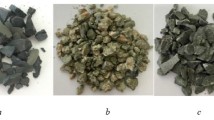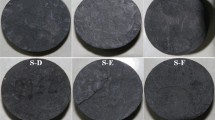At present, research on the influence of water on the physical properties of rocks is mostly focused on the macroscopic angle. Studies on nanoscale pore structure changes caused by water are few. Shale is characterized by good pore structure and high content of hydrophilic clay minerals susceptible to water. Based on this, in this paper the shale samples were obtained from underground layers 3000 m deep in Songliao Basin, Jilin Province, China. The sample parameters are measured by steam adsorption and nitrogen adsorption experiments under different soaking time conditions. The study shows that the pore structure of shale depends mainly on mineral composition and soaking time. With increase in soaking time, the amount of water vapor adsorption first decreases by 10% and then gradually increases. With water migration in the rock some pore structures are filled with shale particles. As the bubble time increases, the ion diffusion causes development of new pores and micro-cracks, and the adsorbed water vapor amount increases. At the microscopic scale, it is of great practical significance to study the nanoscale pore structure and adsorption characteristics of water vapor in the soft for different soaking time, and to further explore the stress characteristics, adsorption law, and gas migration in shale.




Similar content being viewed by others
References
L. Tang and S. Wang, "Progress on the mechanical effects of water-rock chemical action on rock mass deformation and failure," Adv. Earth Sci., 5, 433-439 (1999).
M. He, L. Zhou, D. Li, et at., "Experimental study on water absorption characteristics of deep well mudstone," Chin.J. Rock Mech. Eng., 6, 1113-1120 (2008).
M. He, H. Xie, S. Peng, and Y. Jiang. "Study on rock mechanics of deep mining," Chin. J. Rock Mech. Eng., 16, 2803-2813 (2005).
K. Makhanov, A. Habibi, H. Dehghanpour, et al., "Liquid uptake of gas shales: a workflow to estimate water loss during shut-in periods after fracturing operations," J. Unconvent. Oil Gas Resour, 7, 22-32 (2014).
G. Chalmers and M. Bustin, "The effects and distribution of moisture in gas shale reservoir systems," AAPG ACE (2010).
M.J. Chang, J. Zhou, M.E. Chenevert, et al., "The impact of shale preservation on the petrophysical properties of organic-rich shales," SPE 166419, SPE Annual Technical Conference and Exhibition, 30 Sept.- 2 Oct., New Orleans, Louisiana, USA ( 2013).
Q.H. Wu, B.J. Bai, Y.E. Ma, et al., "Optic imaging of two-phase-flow behavior in ID nanoscale channels," SPE J., 19(5), 793-802 (2014).
J. Zhang, Z. Jin, and M. Yuan, "Mechanism and distribution of shale gas accumulation," Nat. Gas Ind., 7, 15-18, 131-132 (2004).
W.J. Shen, J.M. Wan, Y. Kim, et al., "Porosity calculation, pore size distribution and mineral analysis within shale rocks: Application of scanning electron microscopy," Electron. J. Georech. Eng., 20, 11477-11490 (2015).
R. Qi, Z. Ning, Q. Wang, et al., "Isothermal adsorption of equilibrium water shale considering water vapor pressure," Chin. Sci.: Tech. Sci/, 48(05), 524-536 (2018).
W. Shen, X. Li, X. Lu, et al., "Study on water transport characteristics of shale based on isothermal adsorption," Chin. J. Them: Appl. Mech., 51(03), 932-939 (2019).
Z.A. Erguler and R. Ulusay, "Water-induced variations in mechanical properties of clay-bearing rocks," Int. J. Rock Mech. Min. Sci., 46(2), 35 -370 (2009).
M.E. Chenevert, "Shale control with balanced-activity oil-continuous muds," JPT Trans. AIME, 249, 1309-1316(1970).
J. Li, X. Li, X. Wang, et al., "Quantitative model of inorganic water pore saturation distribution in shale,"Acta Pet. Sin., 37(07), 903-913 ( 2016).
I. Langmuir, "The evaporation, condensation and reflection of molecules and the mechanism of adsorption,"J. Franklin Inst., 183(1), 101-102 (1917).
Acknowledgments
This work was supported by the National Key Research and Development Plan of China (Grant No. 2016YFC0600901), the National Natural Science Foundation of China (Grant No. 51874311), the Special Fund of Basic Research and Operating of China University of Mining & Technology, Beijing (Grant No. 2009QL03), and the Yueqi Outstanding Scholar Award Program of China University of Mining and Technology, Beijing.
Author information
Authors and Affiliations
Corresponding author
Additional information
Translated from Khimiya i Tekhnologiya Topliv i Mazel, No. 3, pp. 95 — 98, May — June, 2020.
Rights and permissions
About this article
Cite this article
Yang, L., Chao, J., Shi, F. et al. Microscopic Mechanism of Water Vapor Adsorption Experimennts on Deep Soft Rock Water Vapor. Chem Technol Fuels Oils 56, 465–471 (2020). https://doi.org/10.1007/s10553-020-01157-z
Published:
Issue Date:
DOI: https://doi.org/10.1007/s10553-020-01157-z




